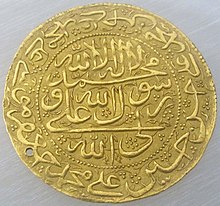Tahmasp II
| Shah Tahmasp II | |
|---|---|
| Shahanshah of Persia, Sahib-i-Qiran, Sultan bar Salatin[1] | |
 Coin minted during the reign of Tahmasp II | |
| Reign | 1729–1732 |
| Predecessor | Ashraf Khan |
| Successor | Abbas III |
| Born | 1704 |
| Died | 11 February 1740 Sabzevar |
| House | Safavi |
| Father | Sultan Husayn |
Tahmasp II (1704? – 11 February 1740) was one of the last Safavid rulers of Persia (Iran).
Biography
Tahmasp was the son of Sultan Husayn, the Shah of Iran at the time. When Husayn was forced to abdicate by the Afghans in 1722, Prince Tahmasp wished to claim the throne. From the besieged Safavid capital, Isfahan, he fled to Tabriz where he established a government. He gained the support of the Sunni Muslims of the Caucasus (even that of the previously rebellious Lezgins), as well as several Qizilbash tribes (including the Afshars, under the control of Iran's future ruler, Nader Shah).
Russo-Persian War
In June 1722, Peter the Great, the then tsar of the neighbouring Russian Empire, declared war on Safavid Iran in an attempt to expand Russian influence in the Caspian and Caucasus regions and to prevent its rival, Ottoman Empire, from territorial gains in the region at the expense of declining Safavid Iran.
The Russian victory ratified for Safavid Irans' cession of their territories in the Northern, Southern Caucasus and contemporary mainland Northern Iran, comprising the cities of Derbent (southern Dagestan) and Baku and their nearby surrounding lands, as well as the provinces of Gilan, Shirvan, Mazandaran, and Astrabad to Russia per the Treaty of Saint Petersburg (1723).[2]
Tahmasp also eventually gained the recognition of both the Ottoman Empire and Russia, each worried about the other gaining too much influence in Iran.[vague]
By 1729, Tahmasp had control of most of the country. Quickly after his foolhardy Ottoman campaign of 1731, he was deposed by the future Nader Shah in 1732 in favor of his son, Abbas III; both were murdered at Sabzevar in 1740 by Nader Shah's eldest son Reza-qoli Mirza.
See also
References
- ^ The Royal Ark
- ^ William Bayne Fisher, P. Avery, G. R. G. Hambly, C. Melville. The Cambridge History of Iran, Volume 7 Cambridge University Press, 10 okt. 1991 ISBN 0521200954 p 319
Sources
- Newman, Andrew J. (2008). Safavid Iran: Rebirth of a Persian Empire. I.B.Tauris. pp. 1–281. ISBN 9780857716613.
{{cite book}}: Invalid|ref=harv(help) - Babaie, Sussan (2004). Slaves of the Shah: New Elites of Safavid Iran. I.B.Tauris. pp. 1–218. ISBN 9781860647215.
{{cite book}}: Invalid|ref=harv(help) - Roemer, H.R. (1986). "The Safavid period". The Cambridge History of Iran, Volume 5: The Timurid and Safavid periods. Cambridge: Cambridge University Press. pp. 189–351. ISBN 9780521200943.
{{cite book}}: Invalid|ref=harv(help) - Lawrence Lockhart, Nadir Shah (London, 1938)
- The Armenian Rebellion of the 1720s and the Threat of Genocidal Reprisal, Armen Ayvazyan, Yerevan 1997
